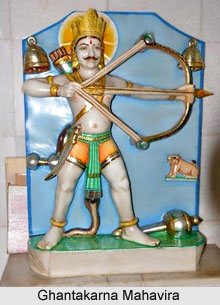 Lord Ghantakarna Mahavira is a revered deity of the Jains. He is regarded as a protector and saviour of the common people. He was a Kshatriya king named Tungabhadra or Mahabal from Shri Nagar. During his time Lord Ghantakarna Mahavira served as the king and warrior of the Himalayan Dynasty. Whenever people were in distress or in problems he came forward to protect them. He is known for saving religious people, castes and virtuous women and unmarried girls from robbers. He used his primary weapons, bow and arrows, to protect innocents. He also possessed a heavy mace. Among his devotees he is known for guarding the pilgrims who come from far off places to visit Shri Parvat near his kingdom from bandits.
Lord Ghantakarna Mahavira is a revered deity of the Jains. He is regarded as a protector and saviour of the common people. He was a Kshatriya king named Tungabhadra or Mahabal from Shri Nagar. During his time Lord Ghantakarna Mahavira served as the king and warrior of the Himalayan Dynasty. Whenever people were in distress or in problems he came forward to protect them. He is known for saving religious people, castes and virtuous women and unmarried girls from robbers. He used his primary weapons, bow and arrows, to protect innocents. He also possessed a heavy mace. Among his devotees he is known for guarding the pilgrims who come from far off places to visit Shri Parvat near his kingdom from bandits.
It is said that Lord Ghantakarna Mahavira liked the sounds of bells known as ghanta in Hindi and bell-shaped ears meaning karma. He was thus known as Ghanta Karna Mahavira (great warrior). The word Mahavira means a great fearless warrior. He was very fond of sukhadi i.e. mixture of jaggery, wheat and ghee.
According to history Lord Ghantakarna Mahavira died fighting a gang of thieves. He was trying to save a group of innocent people who were being tormented and threatened by these thieves. He is revered as the thirtieth Vir or hero in the list of fifty-two Rakshak Devs meaning protector divinity or Virs. The most important temple of Ghantakarna Mahavir is situated in Mahudi.
Mahudi Jain Teerth
Mahudi Jain Teerth is a Jain pilgrimage centre in Gujarat. Is a small village located near the Sabarmati River. The Temple of Mahudi houses the idol of Ghantakarna Mahavira. As the Lord was fond of Sukhadi it is offered to him in the temple. The Prasad is also offered to the devotees and it is consumed within the temple premises.
This article is a stub. You can enrich by adding more information to it. Send your Write Up to content@indianetzone.com




















